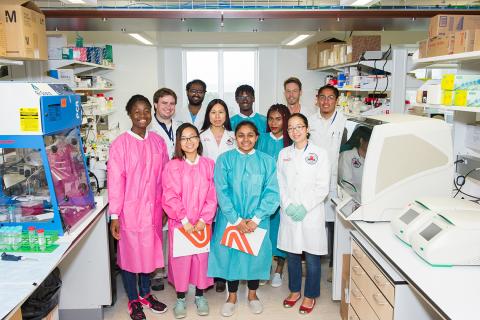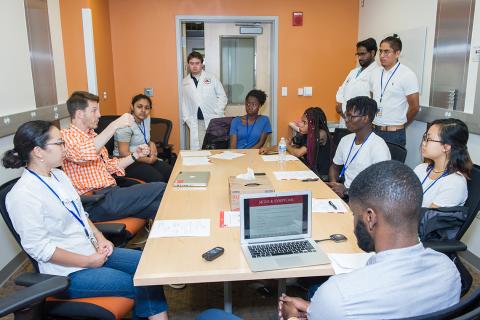'Like Sponges'
Internship Program Benefits High School Students

Photo: Marleen Van Den Neste
This summer, 25 of NIH’s youngest interns spent 6 weeks exploring their dreams in science and preparing for their future under the guidance of the Office of Intramural Training and Education (OITE). The interns, all rising high school seniors, were part of the third annual HiSTEP (High School Scientific Training and Enrichment Program), which invites students from financially disadvantaged local public schools to experience science in both classroom and laboratory settings while also receiving college advice and mentoring.
One of the program’s activities was a networking session on July 25, where each student was assigned three NIH professionals, including investigators, program directors, science administrators and other experts. The event took on a speed-dating style, with students speaking to each professional for 30 minutes then rotating on to the next mentor. The students also visited different labs throughout the week, donning colorful lab coats and joining researchers in their day-to-day routines.
“Dr. Meredith Fox [of NIMH’s Office of Science Policy, Planning and Communications] told me, whenever you’re given an opportunity, never to let go. Take them because you never know where they’ll take you,” said HiSTEP participant Stephany Carrasco. “The experience is giving me a broader view of what science really is. I never knew there were so many different jobs in science, it’s incredible.”

Photo: Marleen Van Den Neste
“We email researchers about participating in the informational interviews and they volunteer their time,” said Dr. Sharolyn Kawakami-Schulz, one of the directors of HiSTEP. “Within the NIH community, we know that training is important. There are many people who have benefited from mentorship and training who are very willing to give back.”
Nathan Phillips, a rising senior at James Hubert Blake High School, took the advice he received to think about creative career options for his interest in sports medicine and kinesiology.
“I want to go into sports medicine, but I also want to do TV production and combine the two and make a show where they talk about different athletes and how they got through their injuries,” he said.
Along with introducing students to numerous opportunities in science, technology, engineering and mathematics (STEM) fields, HiSTEP teaches them how to apply for college and interact with experts who might be able to help them.

Photo: Marleen Van Den Neste
Dr. Kristen Zukosky, who advises HiSTEP students on researching and applying to college, said the application process could be especially overwhelming for students whose high schools or families did not have the resources or knowledge to weigh a diversity of college options. Zukosky has been helping students think about what to look for in a college experience, allowing them to navigate the characteristics of each school without paying sole attention to school rankings.
“I’m constantly impressed by their thirst for knowledge and their passion and devotion for STEM fields,” Zukosky said. “They’re like sponges the whole 6 weeks.”
“I thought the program was just going to be about science, science, science,” said Tooba Malik, a rising senior at Eleanor Roosevelt High School. “But they have lectures on how to have informational interviews, how to write good emails, basic communications skills that I kind of didn’t know about. My emails are way better than I used to write them.”

